Japans nobility Black & White Stock Photos
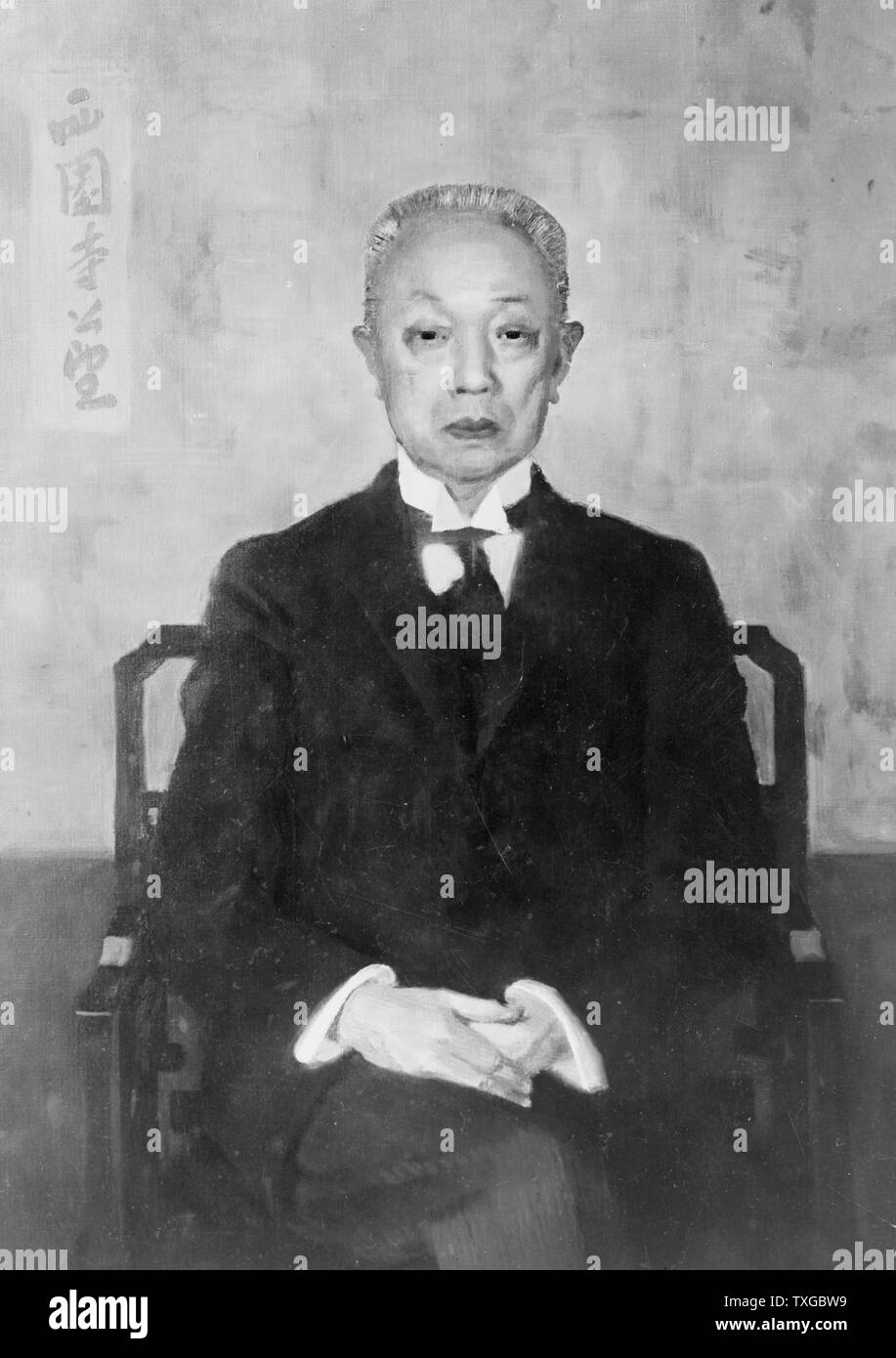 Prince Saionji Kinmochi (December 7, 1849 – November 24, 1940) was a Japanese politician, statesman and twice Prime Minister of Japan. His title does not signify the son of an emperor, but the highest rank of Japanese hereditary nobility, he was elevated from marquis to prince in 1920. As the last surviving genro, he was Japan's most honoured statesman of the 1920s and 1930s. Stock Photohttps://www.alamy.com/image-license-details/?v=1https://www.alamy.com/prince-saionji-kinmochi-december-7-1849-november-24-1940-was-a-japanese-politician-statesman-and-twice-prime-minister-of-japan-his-title-does-not-signify-the-son-of-an-emperor-but-the-highest-rank-of-japanese-hereditary-nobility-he-was-elevated-from-marquis-to-prince-in-1920-as-the-last-surviving-genro-he-was-japans-most-honoured-statesman-of-the-1920s-and-1930s-image257286773.html
Prince Saionji Kinmochi (December 7, 1849 – November 24, 1940) was a Japanese politician, statesman and twice Prime Minister of Japan. His title does not signify the son of an emperor, but the highest rank of Japanese hereditary nobility, he was elevated from marquis to prince in 1920. As the last surviving genro, he was Japan's most honoured statesman of the 1920s and 1930s. Stock Photohttps://www.alamy.com/image-license-details/?v=1https://www.alamy.com/prince-saionji-kinmochi-december-7-1849-november-24-1940-was-a-japanese-politician-statesman-and-twice-prime-minister-of-japan-his-title-does-not-signify-the-son-of-an-emperor-but-the-highest-rank-of-japanese-hereditary-nobility-he-was-elevated-from-marquis-to-prince-in-1920-as-the-last-surviving-genro-he-was-japans-most-honoured-statesman-of-the-1920s-and-1930s-image257286773.htmlRMTXGBW9–Prince Saionji Kinmochi (December 7, 1849 – November 24, 1940) was a Japanese politician, statesman and twice Prime Minister of Japan. His title does not signify the son of an emperor, but the highest rank of Japanese hereditary nobility, he was elevated from marquis to prince in 1920. As the last surviving genro, he was Japan's most honoured statesman of the 1920s and 1930s.
 First picture of Japan's ancient imperial football game, Kemari. This is the first picture ever taken of Japan's Imperial Court football players. The game, the centuries, the exclusive pastime of the Japanese royal household, is still played by young Japanese nobleman in Kyoto, picturesque format capital of the Empire, where it has been in vogue since 642 AD. In contrast with the vigourous action of British football, the principal object of the game is to keep the deerskin ball bouncing continuously in the air from the point of the toe, grace and dexterity are the qualities most admired. Each Stock Photohttps://www.alamy.com/image-license-details/?v=1https://www.alamy.com/first-picture-of-japans-ancient-imperial-football-game-kemari-this-is-the-first-picture-ever-taken-of-japans-imperial-court-football-players-the-game-the-centuries-the-exclusive-pastime-of-the-japanese-royal-household-is-still-played-by-young-japanese-nobleman-in-kyoto-picturesque-format-capital-of-the-empire-where-it-has-been-in-vogue-since-642-ad-in-contrast-with-the-vigourous-action-of-british-football-the-principal-object-of-the-game-is-to-keep-the-deerskin-ball-bouncing-continuously-in-the-air-from-the-point-of-the-toe-grace-and-dexterity-are-the-qualities-most-admired-each-image359621309.html
First picture of Japan's ancient imperial football game, Kemari. This is the first picture ever taken of Japan's Imperial Court football players. The game, the centuries, the exclusive pastime of the Japanese royal household, is still played by young Japanese nobleman in Kyoto, picturesque format capital of the Empire, where it has been in vogue since 642 AD. In contrast with the vigourous action of British football, the principal object of the game is to keep the deerskin ball bouncing continuously in the air from the point of the toe, grace and dexterity are the qualities most admired. Each Stock Photohttps://www.alamy.com/image-license-details/?v=1https://www.alamy.com/first-picture-of-japans-ancient-imperial-football-game-kemari-this-is-the-first-picture-ever-taken-of-japans-imperial-court-football-players-the-game-the-centuries-the-exclusive-pastime-of-the-japanese-royal-household-is-still-played-by-young-japanese-nobleman-in-kyoto-picturesque-format-capital-of-the-empire-where-it-has-been-in-vogue-since-642-ad-in-contrast-with-the-vigourous-action-of-british-football-the-principal-object-of-the-game-is-to-keep-the-deerskin-ball-bouncing-continuously-in-the-air-from-the-point-of-the-toe-grace-and-dexterity-are-the-qualities-most-admired-each-image359621309.htmlRM2BW24J5–First picture of Japan's ancient imperial football game, Kemari. This is the first picture ever taken of Japan's Imperial Court football players. The game, the centuries, the exclusive pastime of the Japanese royal household, is still played by young Japanese nobleman in Kyoto, picturesque format capital of the Empire, where it has been in vogue since 642 AD. In contrast with the vigourous action of British football, the principal object of the game is to keep the deerskin ball bouncing continuously in the air from the point of the toe, grace and dexterity are the qualities most admired. Each
 Prince Saionji Kinmochi (1849-1940) was a Japanese politician, statesman and twice Prime Minister of Japan. His title does not signify the son of an emperor, but the highest rank of Japanese hereditary nobility;he was elevated from marquis to prince in 1920. As the last surviving genro, he was Japan's most honoured statesman of the 1920s and 1930s. Stock Photohttps://www.alamy.com/image-license-details/?v=1https://www.alamy.com/stock-photo-prince-saionji-kinmochi-1849-1940-was-a-japanese-politician-statesman-90846180.html
Prince Saionji Kinmochi (1849-1940) was a Japanese politician, statesman and twice Prime Minister of Japan. His title does not signify the son of an emperor, but the highest rank of Japanese hereditary nobility;he was elevated from marquis to prince in 1920. As the last surviving genro, he was Japan's most honoured statesman of the 1920s and 1930s. Stock Photohttps://www.alamy.com/image-license-details/?v=1https://www.alamy.com/stock-photo-prince-saionji-kinmochi-1849-1940-was-a-japanese-politician-statesman-90846180.htmlRMF7PB6C–Prince Saionji Kinmochi (1849-1940) was a Japanese politician, statesman and twice Prime Minister of Japan. His title does not signify the son of an emperor, but the highest rank of Japanese hereditary nobility;he was elevated from marquis to prince in 1920. As the last surviving genro, he was Japan's most honoured statesman of the 1920s and 1930s.
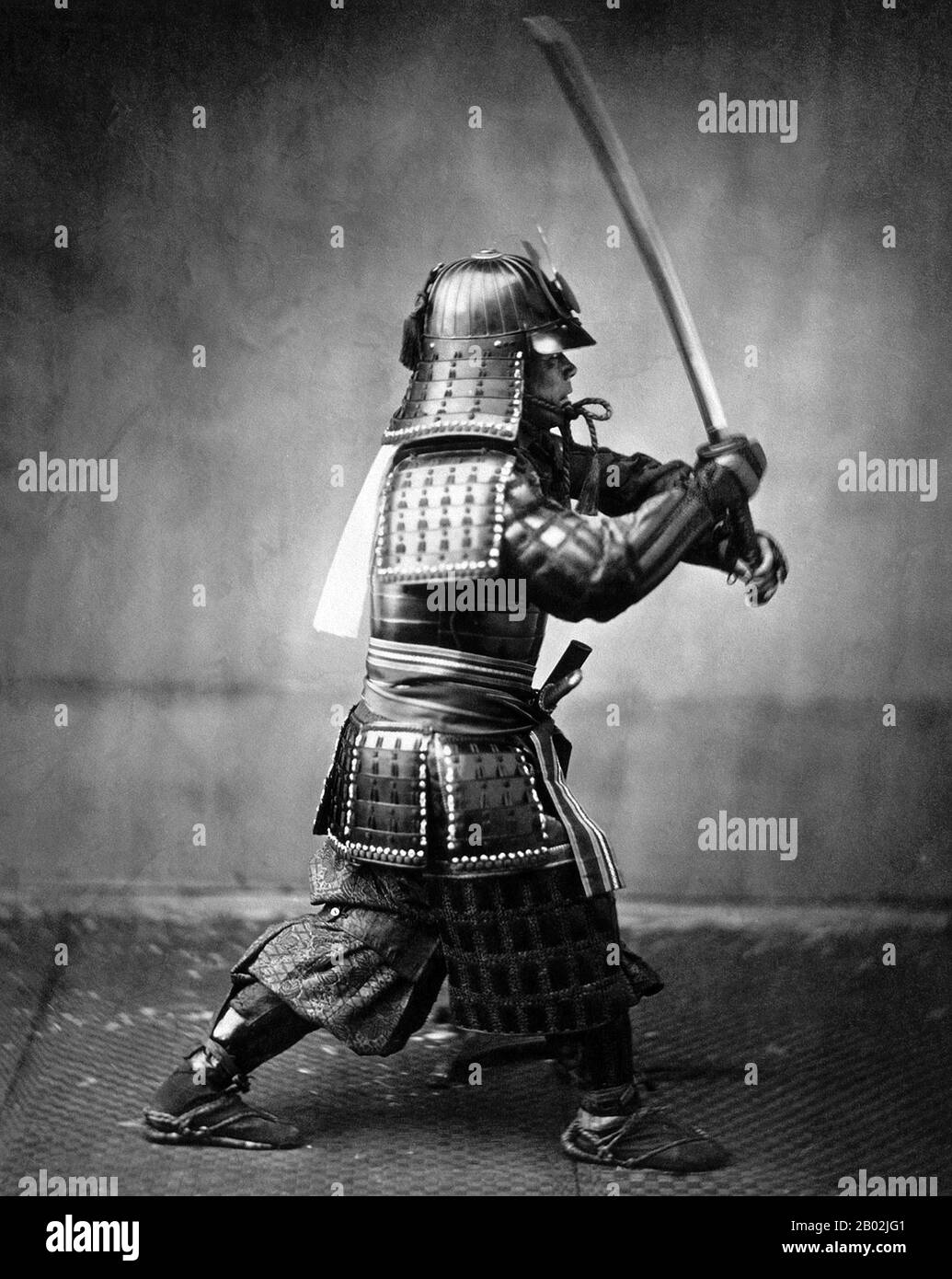 Samurai is the term for the military nobility of pre-industrial Japan. By the end of the 12th century, samurai became almost entirely synonymous with bushi, and the word was closely associated with the middle and upper echelons of the warrior class. The samurai followed a set of rules that came to be known as Bushidō. While they numbered less than ten percent of Japan's population, samurai teachings can still be found today in both everyday life and in martial arts such as Kendō, meaning the way of the sword. Stock Photohttps://www.alamy.com/image-license-details/?v=1https://www.alamy.com/samurai-is-the-term-for-the-military-nobility-of-pre-industrial-japan-by-the-end-of-the-12th-century-samurai-became-almost-entirely-synonymous-with-bushi-and-the-word-was-closely-associated-with-the-middle-and-upper-echelons-of-the-warrior-class-the-samurai-followed-a-set-of-rules-that-came-to-be-known-as-bushid-while-they-numbered-less-than-ten-percent-of-japans-population-samurai-teachings-can-still-be-found-today-in-both-everyday-life-and-in-martial-arts-such-as-kend-meaning-the-way-of-the-sword-image344265825.html
Samurai is the term for the military nobility of pre-industrial Japan. By the end of the 12th century, samurai became almost entirely synonymous with bushi, and the word was closely associated with the middle and upper echelons of the warrior class. The samurai followed a set of rules that came to be known as Bushidō. While they numbered less than ten percent of Japan's population, samurai teachings can still be found today in both everyday life and in martial arts such as Kendō, meaning the way of the sword. Stock Photohttps://www.alamy.com/image-license-details/?v=1https://www.alamy.com/samurai-is-the-term-for-the-military-nobility-of-pre-industrial-japan-by-the-end-of-the-12th-century-samurai-became-almost-entirely-synonymous-with-bushi-and-the-word-was-closely-associated-with-the-middle-and-upper-echelons-of-the-warrior-class-the-samurai-followed-a-set-of-rules-that-came-to-be-known-as-bushid-while-they-numbered-less-than-ten-percent-of-japans-population-samurai-teachings-can-still-be-found-today-in-both-everyday-life-and-in-martial-arts-such-as-kend-meaning-the-way-of-the-sword-image344265825.htmlRM2B02JG1–Samurai is the term for the military nobility of pre-industrial Japan. By the end of the 12th century, samurai became almost entirely synonymous with bushi, and the word was closely associated with the middle and upper echelons of the warrior class. The samurai followed a set of rules that came to be known as Bushidō. While they numbered less than ten percent of Japan's population, samurai teachings can still be found today in both everyday life and in martial arts such as Kendō, meaning the way of the sword.
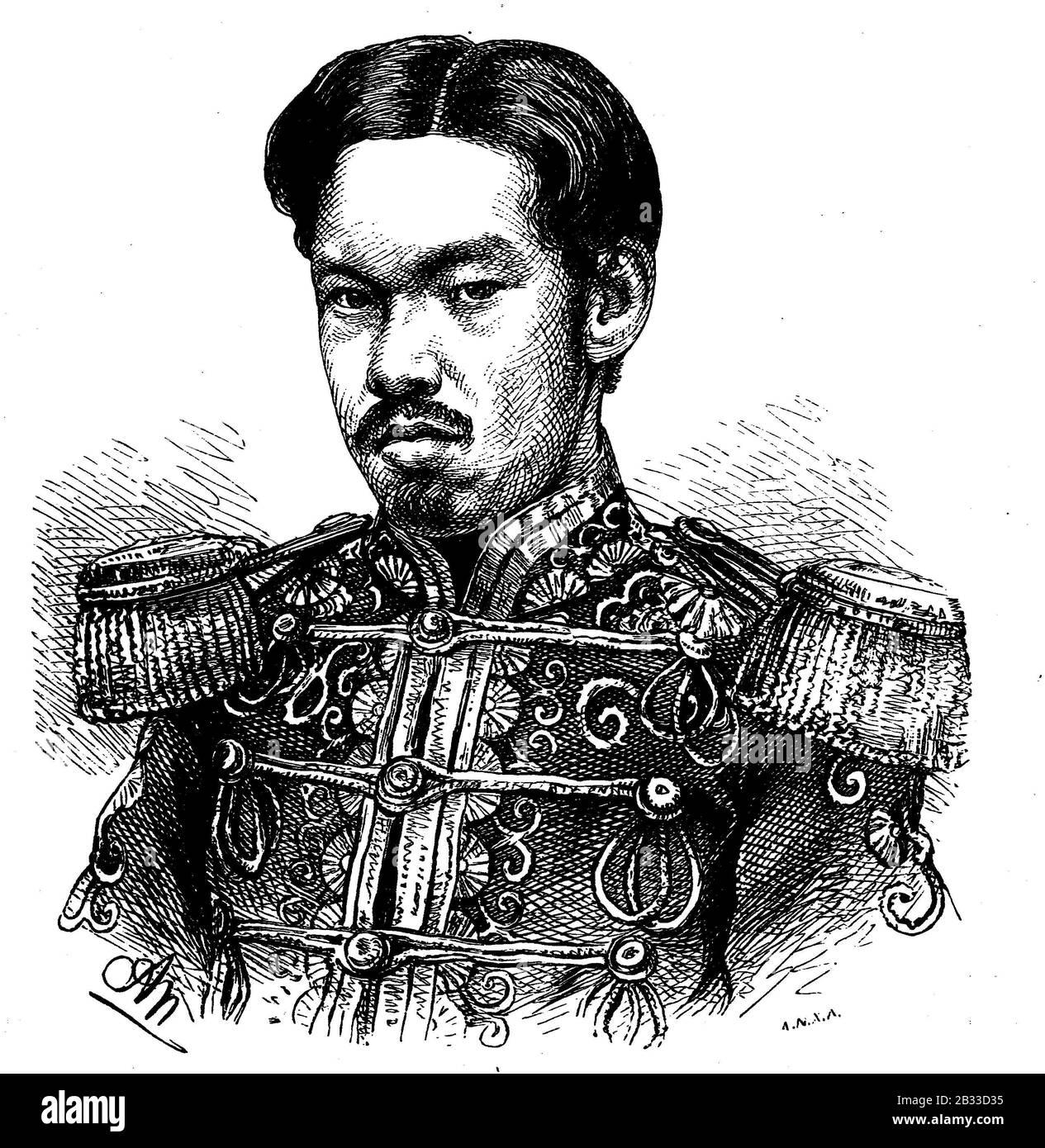 Emperor Meiji, 3 November 1852 - 30 July 1912-), or Meiji the Great, Mutsuhito, was the 122nd Emperor of Japan according to the traditional order of succession, reigning from 3 February 1867 until his death on 30 July 1912 / Kaiser Meiji, 3. November 1852 - 30. Juli 1912-) oder Meiji der Große, Mutsuhito, war der 122. Kaiser Japans gemäß der traditionellen Reihenfolge der Nachfolge, die vom 3. Februar 1867 bis zu seinem Tod am 30. Juli 1912 regierte, Historisch, digital improved reproduction of an original from the 19th century / digitale Reproduktion einer Originalvorlage aus dem 19. Jahrhu Stock Photohttps://www.alamy.com/image-license-details/?v=1https://www.alamy.com/emperor-meiji-3-november-1852-30-july-1912-or-meiji-the-great-mutsuhito-was-the-122nd-emperor-of-japan-according-to-the-traditional-order-of-succession-reigning-from-3-february-1867-until-his-death-on-30-july-1912-kaiser-meiji-3-november-1852-30-juli-1912-oder-meiji-der-groe-mutsuhito-war-der-122-kaiser-japans-gem-der-traditionellen-reihenfolge-der-nachfolge-die-vom-3-februar-1867-bis-zu-seinem-tod-am-30-juli-1912-regierte-historisch-digital-improved-reproduction-of-an-original-from-the-19th-century-digitale-reproduktion-einer-originalvorlage-aus-dem-19-jahrhu-image346127465.html
Emperor Meiji, 3 November 1852 - 30 July 1912-), or Meiji the Great, Mutsuhito, was the 122nd Emperor of Japan according to the traditional order of succession, reigning from 3 February 1867 until his death on 30 July 1912 / Kaiser Meiji, 3. November 1852 - 30. Juli 1912-) oder Meiji der Große, Mutsuhito, war der 122. Kaiser Japans gemäß der traditionellen Reihenfolge der Nachfolge, die vom 3. Februar 1867 bis zu seinem Tod am 30. Juli 1912 regierte, Historisch, digital improved reproduction of an original from the 19th century / digitale Reproduktion einer Originalvorlage aus dem 19. Jahrhu Stock Photohttps://www.alamy.com/image-license-details/?v=1https://www.alamy.com/emperor-meiji-3-november-1852-30-july-1912-or-meiji-the-great-mutsuhito-was-the-122nd-emperor-of-japan-according-to-the-traditional-order-of-succession-reigning-from-3-february-1867-until-his-death-on-30-july-1912-kaiser-meiji-3-november-1852-30-juli-1912-oder-meiji-der-groe-mutsuhito-war-der-122-kaiser-japans-gem-der-traditionellen-reihenfolge-der-nachfolge-die-vom-3-februar-1867-bis-zu-seinem-tod-am-30-juli-1912-regierte-historisch-digital-improved-reproduction-of-an-original-from-the-19th-century-digitale-reproduktion-einer-originalvorlage-aus-dem-19-jahrhu-image346127465.htmlRF2B33D35–Emperor Meiji, 3 November 1852 - 30 July 1912-), or Meiji the Great, Mutsuhito, was the 122nd Emperor of Japan according to the traditional order of succession, reigning from 3 February 1867 until his death on 30 July 1912 / Kaiser Meiji, 3. November 1852 - 30. Juli 1912-) oder Meiji der Große, Mutsuhito, war der 122. Kaiser Japans gemäß der traditionellen Reihenfolge der Nachfolge, die vom 3. Februar 1867 bis zu seinem Tod am 30. Juli 1912 regierte, Historisch, digital improved reproduction of an original from the 19th century / digitale Reproduktion einer Originalvorlage aus dem 19. Jahrhu
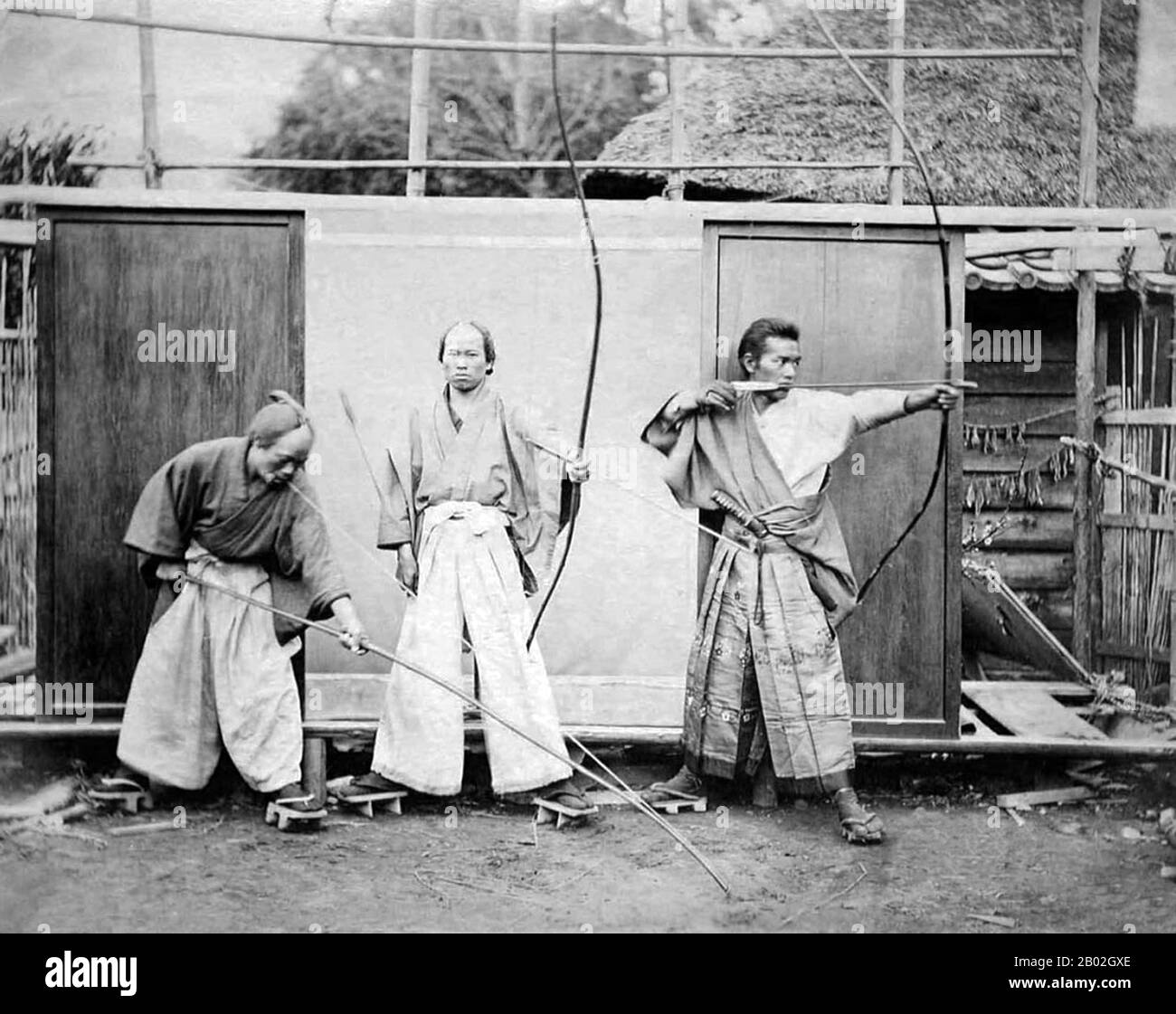 Samurai is the term for the military nobility of pre-industrial Japan. By the end of the 12th century, samurai became almost entirely synonymous with bushi, and the word was closely associated with the middle and upper echelons of the warrior class. The samurai followed a set of rules that came to be known as Bushidō. While they numbered less than ten percent of Japan's population, samurai teachings can still be found today in both everyday life and in martial arts such as Kendō, meaning the way of the sword. Stock Photohttps://www.alamy.com/image-license-details/?v=1https://www.alamy.com/samurai-is-the-term-for-the-military-nobility-of-pre-industrial-japan-by-the-end-of-the-12th-century-samurai-became-almost-entirely-synonymous-with-bushi-and-the-word-was-closely-associated-with-the-middle-and-upper-echelons-of-the-warrior-class-the-samurai-followed-a-set-of-rules-that-came-to-be-known-as-bushid-while-they-numbered-less-than-ten-percent-of-japans-population-samurai-teachings-can-still-be-found-today-in-both-everyday-life-and-in-martial-arts-such-as-kend-meaning-the-way-of-the-sword-image344264550.html
Samurai is the term for the military nobility of pre-industrial Japan. By the end of the 12th century, samurai became almost entirely synonymous with bushi, and the word was closely associated with the middle and upper echelons of the warrior class. The samurai followed a set of rules that came to be known as Bushidō. While they numbered less than ten percent of Japan's population, samurai teachings can still be found today in both everyday life and in martial arts such as Kendō, meaning the way of the sword. Stock Photohttps://www.alamy.com/image-license-details/?v=1https://www.alamy.com/samurai-is-the-term-for-the-military-nobility-of-pre-industrial-japan-by-the-end-of-the-12th-century-samurai-became-almost-entirely-synonymous-with-bushi-and-the-word-was-closely-associated-with-the-middle-and-upper-echelons-of-the-warrior-class-the-samurai-followed-a-set-of-rules-that-came-to-be-known-as-bushid-while-they-numbered-less-than-ten-percent-of-japans-population-samurai-teachings-can-still-be-found-today-in-both-everyday-life-and-in-martial-arts-such-as-kend-meaning-the-way-of-the-sword-image344264550.htmlRM2B02GXE–Samurai is the term for the military nobility of pre-industrial Japan. By the end of the 12th century, samurai became almost entirely synonymous with bushi, and the word was closely associated with the middle and upper echelons of the warrior class. The samurai followed a set of rules that came to be known as Bushidō. While they numbered less than ten percent of Japan's population, samurai teachings can still be found today in both everyday life and in martial arts such as Kendō, meaning the way of the sword.
 Prince Saionji Kinmochi (December 7, 1849 – November 24, 1940) was a Japanese politician, statesman and twice Prime Minister of Japan. His title does not signify the son of an emperor, but the highest rank of Japanese hereditary nobility, he was elevated from marquis to prince in 1920. As the last surviving genro, he was Japan's most honoured statesman of the 1920s and 1930s. Stock Photohttps://www.alamy.com/image-license-details/?v=1https://www.alamy.com/stock-photo-prince-saionji-kinmochi-december-7-1849-november-24-1940-was-a-japanese-90833304.html
Prince Saionji Kinmochi (December 7, 1849 – November 24, 1940) was a Japanese politician, statesman and twice Prime Minister of Japan. His title does not signify the son of an emperor, but the highest rank of Japanese hereditary nobility, he was elevated from marquis to prince in 1920. As the last surviving genro, he was Japan's most honoured statesman of the 1920s and 1930s. Stock Photohttps://www.alamy.com/image-license-details/?v=1https://www.alamy.com/stock-photo-prince-saionji-kinmochi-december-7-1849-november-24-1940-was-a-japanese-90833304.htmlRMF7NPPG–Prince Saionji Kinmochi (December 7, 1849 – November 24, 1940) was a Japanese politician, statesman and twice Prime Minister of Japan. His title does not signify the son of an emperor, but the highest rank of Japanese hereditary nobility, he was elevated from marquis to prince in 1920. As the last surviving genro, he was Japan's most honoured statesman of the 1920s and 1930s.
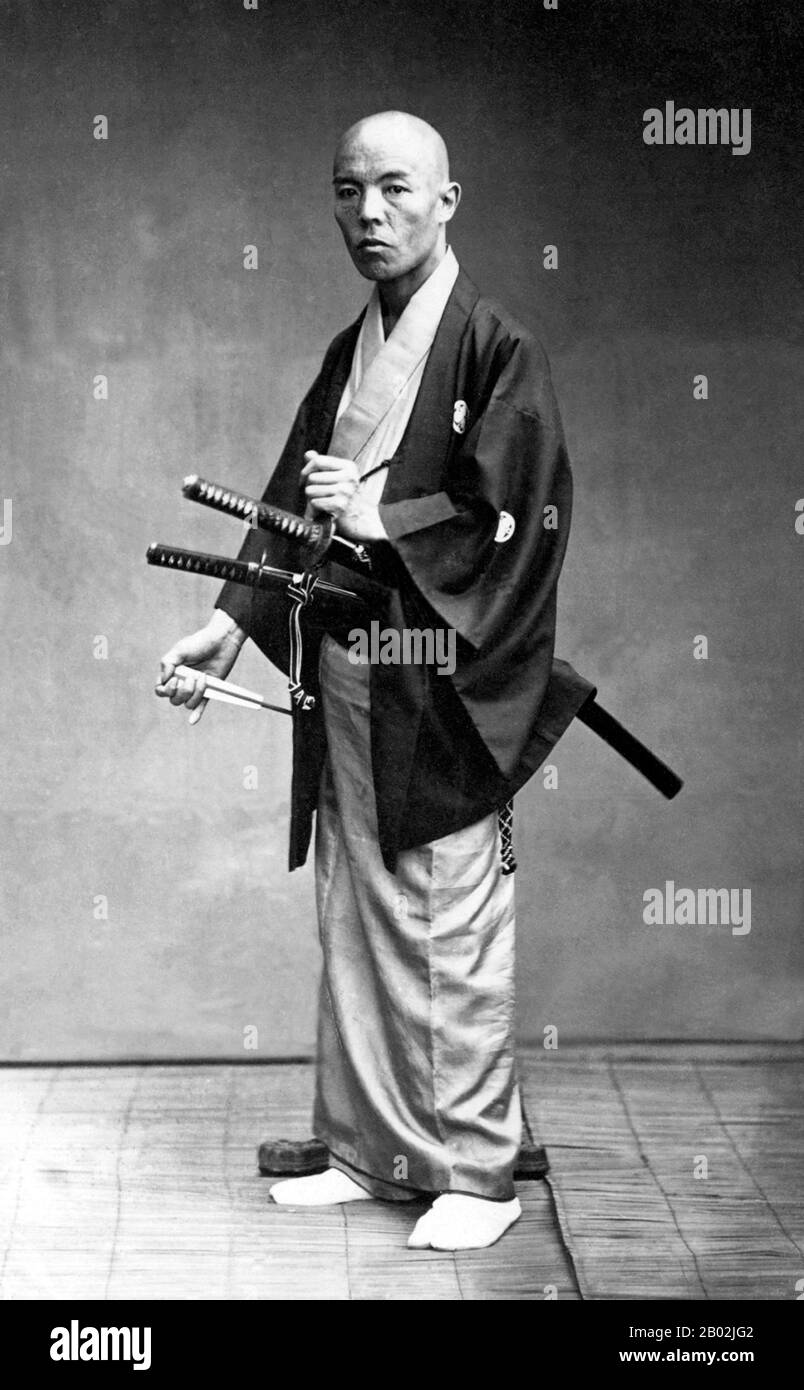 Samurai is the term for the military nobility of pre-industrial Japan. By the end of the 12th century, samurai became almost entirely synonymous with bushi, and the word was closely associated with the middle and upper echelons of the warrior class. The samurai followed a set of rules that came to be known as Bushidō. While they numbered less than ten percent of Japan's population, samurai teachings can still be found today in both everyday life and in martial arts such as Kendō, meaning the way of the sword. Stock Photohttps://www.alamy.com/image-license-details/?v=1https://www.alamy.com/samurai-is-the-term-for-the-military-nobility-of-pre-industrial-japan-by-the-end-of-the-12th-century-samurai-became-almost-entirely-synonymous-with-bushi-and-the-word-was-closely-associated-with-the-middle-and-upper-echelons-of-the-warrior-class-the-samurai-followed-a-set-of-rules-that-came-to-be-known-as-bushid-while-they-numbered-less-than-ten-percent-of-japans-population-samurai-teachings-can-still-be-found-today-in-both-everyday-life-and-in-martial-arts-such-as-kend-meaning-the-way-of-the-sword-image344265826.html
Samurai is the term for the military nobility of pre-industrial Japan. By the end of the 12th century, samurai became almost entirely synonymous with bushi, and the word was closely associated with the middle and upper echelons of the warrior class. The samurai followed a set of rules that came to be known as Bushidō. While they numbered less than ten percent of Japan's population, samurai teachings can still be found today in both everyday life and in martial arts such as Kendō, meaning the way of the sword. Stock Photohttps://www.alamy.com/image-license-details/?v=1https://www.alamy.com/samurai-is-the-term-for-the-military-nobility-of-pre-industrial-japan-by-the-end-of-the-12th-century-samurai-became-almost-entirely-synonymous-with-bushi-and-the-word-was-closely-associated-with-the-middle-and-upper-echelons-of-the-warrior-class-the-samurai-followed-a-set-of-rules-that-came-to-be-known-as-bushid-while-they-numbered-less-than-ten-percent-of-japans-population-samurai-teachings-can-still-be-found-today-in-both-everyday-life-and-in-martial-arts-such-as-kend-meaning-the-way-of-the-sword-image344265826.htmlRM2B02JG2–Samurai is the term for the military nobility of pre-industrial Japan. By the end of the 12th century, samurai became almost entirely synonymous with bushi, and the word was closely associated with the middle and upper echelons of the warrior class. The samurai followed a set of rules that came to be known as Bushidō. While they numbered less than ten percent of Japan's population, samurai teachings can still be found today in both everyday life and in martial arts such as Kendō, meaning the way of the sword.
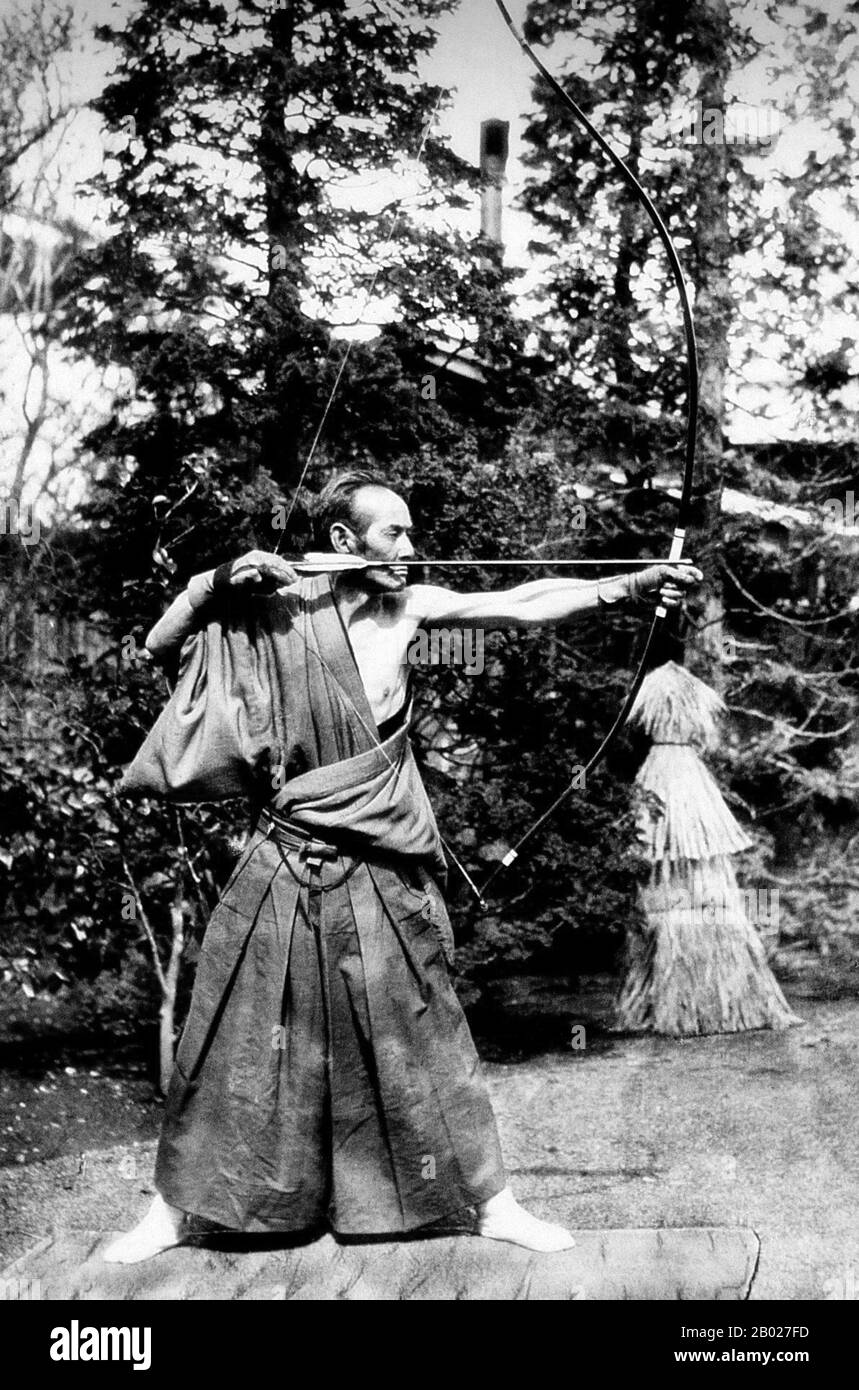 Samurai (侍), usually referred to in Japanese as bushi (武士) or buke (武家), were the military nobility of medieval and early-modern Japan. By the end of the 12th century, samurai became almost entirely synonymous with bushi, and the word was closely associated with the middle and upper echelons of the warrior class. The samurai followed a set of rules that came to be known as bushidō. While the samurai numbered less than 10% of Japan's population, their teachings can still be found today in both everyday life and in modern Japanese martial arts. Stock Photohttps://www.alamy.com/image-license-details/?v=1https://www.alamy.com/samurai-usually-referred-to-in-japanese-as-bushi-or-buke-were-the-military-nobility-of-medieval-and-early-modern-japan-by-the-end-of-the-12th-century-samurai-became-almost-entirely-synonymous-with-bushi-and-the-word-was-closely-associated-with-the-middle-and-upper-echelons-of-the-warrior-class-the-samurai-followed-a-set-of-rules-that-came-to-be-known-as-bushid-while-the-samurai-numbered-less-than-10-of-japans-population-their-teachings-can-still-be-found-today-in-both-everyday-life-and-in-modern-japanese-martial-arts-image344257185.html
Samurai (侍), usually referred to in Japanese as bushi (武士) or buke (武家), were the military nobility of medieval and early-modern Japan. By the end of the 12th century, samurai became almost entirely synonymous with bushi, and the word was closely associated with the middle and upper echelons of the warrior class. The samurai followed a set of rules that came to be known as bushidō. While the samurai numbered less than 10% of Japan's population, their teachings can still be found today in both everyday life and in modern Japanese martial arts. Stock Photohttps://www.alamy.com/image-license-details/?v=1https://www.alamy.com/samurai-usually-referred-to-in-japanese-as-bushi-or-buke-were-the-military-nobility-of-medieval-and-early-modern-japan-by-the-end-of-the-12th-century-samurai-became-almost-entirely-synonymous-with-bushi-and-the-word-was-closely-associated-with-the-middle-and-upper-echelons-of-the-warrior-class-the-samurai-followed-a-set-of-rules-that-came-to-be-known-as-bushid-while-the-samurai-numbered-less-than-10-of-japans-population-their-teachings-can-still-be-found-today-in-both-everyday-life-and-in-modern-japanese-martial-arts-image344257185.htmlRM2B027FD–Samurai (侍), usually referred to in Japanese as bushi (武士) or buke (武家), were the military nobility of medieval and early-modern Japan. By the end of the 12th century, samurai became almost entirely synonymous with bushi, and the word was closely associated with the middle and upper echelons of the warrior class. The samurai followed a set of rules that came to be known as bushidō. While the samurai numbered less than 10% of Japan's population, their teachings can still be found today in both everyday life and in modern Japanese martial arts.
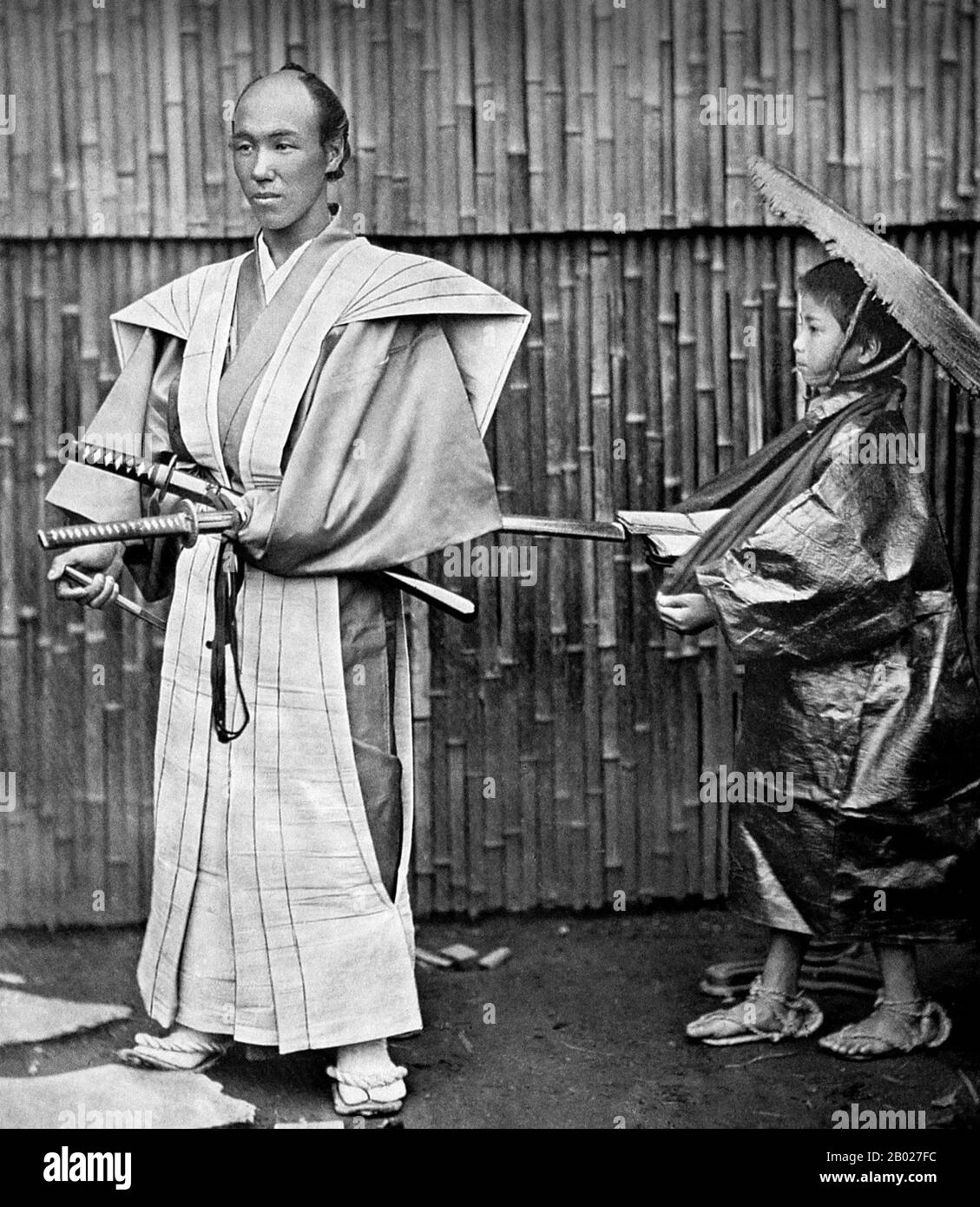 Samurai (侍), usually referred to in Japanese as bushi (武士) or buke (武家), were the military nobility of medieval and early-modern Japan. By the end of the 12th century, samurai became almost entirely synonymous with bushi, and the word was closely associated with the middle and upper echelons of the warrior class. The samurai followed a set of rules that came to be known as bushidō. While the samurai numbered less than 10% of Japan's population, their teachings can still be found today in both everyday life and in modern Japanese martial arts. Stock Photohttps://www.alamy.com/image-license-details/?v=1https://www.alamy.com/samurai-usually-referred-to-in-japanese-as-bushi-or-buke-were-the-military-nobility-of-medieval-and-early-modern-japan-by-the-end-of-the-12th-century-samurai-became-almost-entirely-synonymous-with-bushi-and-the-word-was-closely-associated-with-the-middle-and-upper-echelons-of-the-warrior-class-the-samurai-followed-a-set-of-rules-that-came-to-be-known-as-bushid-while-the-samurai-numbered-less-than-10-of-japans-population-their-teachings-can-still-be-found-today-in-both-everyday-life-and-in-modern-japanese-martial-arts-image344257184.html
Samurai (侍), usually referred to in Japanese as bushi (武士) or buke (武家), were the military nobility of medieval and early-modern Japan. By the end of the 12th century, samurai became almost entirely synonymous with bushi, and the word was closely associated with the middle and upper echelons of the warrior class. The samurai followed a set of rules that came to be known as bushidō. While the samurai numbered less than 10% of Japan's population, their teachings can still be found today in both everyday life and in modern Japanese martial arts. Stock Photohttps://www.alamy.com/image-license-details/?v=1https://www.alamy.com/samurai-usually-referred-to-in-japanese-as-bushi-or-buke-were-the-military-nobility-of-medieval-and-early-modern-japan-by-the-end-of-the-12th-century-samurai-became-almost-entirely-synonymous-with-bushi-and-the-word-was-closely-associated-with-the-middle-and-upper-echelons-of-the-warrior-class-the-samurai-followed-a-set-of-rules-that-came-to-be-known-as-bushid-while-the-samurai-numbered-less-than-10-of-japans-population-their-teachings-can-still-be-found-today-in-both-everyday-life-and-in-modern-japanese-martial-arts-image344257184.htmlRM2B027FC–Samurai (侍), usually referred to in Japanese as bushi (武士) or buke (武家), were the military nobility of medieval and early-modern Japan. By the end of the 12th century, samurai became almost entirely synonymous with bushi, and the word was closely associated with the middle and upper echelons of the warrior class. The samurai followed a set of rules that came to be known as bushidō. While the samurai numbered less than 10% of Japan's population, their teachings can still be found today in both everyday life and in modern Japanese martial arts.
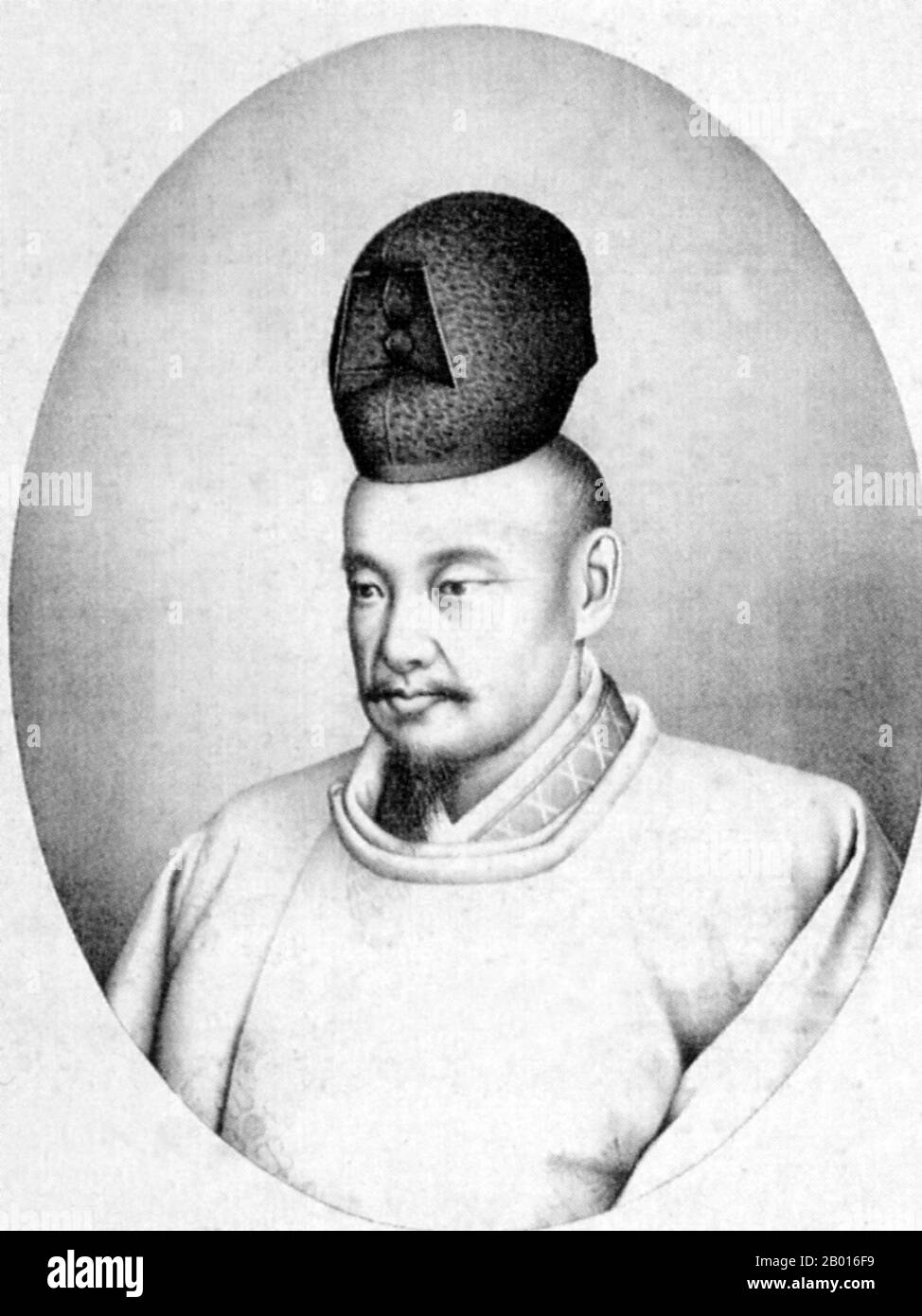 Japan: Tokugawa Nariaki (4 April 1800 - 29 September 1860), Daimyo of Mito Domain (r. 1829-1844). Portrait, mid-19th century. Tokugawa Nariaki, born Torasaburo and also known as Keisaburo, was a prominent Japanese daimyo who ruled the Mito domain (now Ibaraki prefecture). He became daimyo in 1829, and was leader of the Joi ('expel the barbarian') party, who were xenophobic and favoured restoring power to the Emperor as well as isolating Japan from the world. His actions led to the rise of nationalism and the Meiji Restoration. His son, Tokugawa Yoshinobu, would become Japan's last shogun. Stock Photohttps://www.alamy.com/image-license-details/?v=1https://www.alamy.com/japan-tokugawa-nariaki-4-april-1800-29-september-1860-daimyo-of-mito-domain-r-1829-1844-portrait-mid-19th-century-tokugawa-nariaki-born-torasaburo-and-also-known-as-keisaburo-was-a-prominent-japanese-daimyo-who-ruled-the-mito-domain-now-ibaraki-prefecture-he-became-daimyo-in-1829-and-was-leader-of-the-joi-expel-the-barbarian-party-who-were-xenophobic-and-favoured-restoring-power-to-the-emperor-as-well-as-isolating-japan-from-the-world-his-actions-led-to-the-rise-of-nationalism-and-the-meiji-restoration-his-son-tokugawa-yoshinobu-would-become-japans-last-shogun-image344234445.html
Japan: Tokugawa Nariaki (4 April 1800 - 29 September 1860), Daimyo of Mito Domain (r. 1829-1844). Portrait, mid-19th century. Tokugawa Nariaki, born Torasaburo and also known as Keisaburo, was a prominent Japanese daimyo who ruled the Mito domain (now Ibaraki prefecture). He became daimyo in 1829, and was leader of the Joi ('expel the barbarian') party, who were xenophobic and favoured restoring power to the Emperor as well as isolating Japan from the world. His actions led to the rise of nationalism and the Meiji Restoration. His son, Tokugawa Yoshinobu, would become Japan's last shogun. Stock Photohttps://www.alamy.com/image-license-details/?v=1https://www.alamy.com/japan-tokugawa-nariaki-4-april-1800-29-september-1860-daimyo-of-mito-domain-r-1829-1844-portrait-mid-19th-century-tokugawa-nariaki-born-torasaburo-and-also-known-as-keisaburo-was-a-prominent-japanese-daimyo-who-ruled-the-mito-domain-now-ibaraki-prefecture-he-became-daimyo-in-1829-and-was-leader-of-the-joi-expel-the-barbarian-party-who-were-xenophobic-and-favoured-restoring-power-to-the-emperor-as-well-as-isolating-japan-from-the-world-his-actions-led-to-the-rise-of-nationalism-and-the-meiji-restoration-his-son-tokugawa-yoshinobu-would-become-japans-last-shogun-image344234445.htmlRM2B016F9–Japan: Tokugawa Nariaki (4 April 1800 - 29 September 1860), Daimyo of Mito Domain (r. 1829-1844). Portrait, mid-19th century. Tokugawa Nariaki, born Torasaburo and also known as Keisaburo, was a prominent Japanese daimyo who ruled the Mito domain (now Ibaraki prefecture). He became daimyo in 1829, and was leader of the Joi ('expel the barbarian') party, who were xenophobic and favoured restoring power to the Emperor as well as isolating Japan from the world. His actions led to the rise of nationalism and the Meiji Restoration. His son, Tokugawa Yoshinobu, would become Japan's last shogun.